Chapter 4The risk analysis process: risk assessment
In this chapter, we look closer into the different activities of a risk assessment, covering identification of initiating events, cause analysis, consequence analysis as well as risk description (risk picture); refer Figure 1.2.
4.1 Identification of initiating events
The first step of the execution part of a risk analysis is identification of initiating events. If our focus is on hazards (threats), then we are talking about a hazard identification (threat identification). It is often said that ‘what you have not identified, you cannot deal with’. It is difficult to avoid or to reduce the consequences of events that one has not identified. For this reason, identification of initiating events is a critical task of the analysis. However, care has to be taken to prevent this task from becoming a routine. When one performs similar types of analyses, it is common to copy the list of hazards and threats from previous analyses. By doing this, one may overlook special aspects and features of the system being considered.
It is therefore important that identification of initiating events be carried out in a structured and systematic manner and it involves persons having the necessary competence. Figure 4.1 illustrates how such an activity can be carried out with respect to hazard identification.

Figure 4.1 Hazard identification.
Get Risk Analysis, 2nd Edition now with the O’Reilly learning platform.
O’Reilly members experience books, live events, courses curated by job role, and more from O’Reilly and nearly 200 top publishers.

